Inertial measurement units are used in a host of motion and orientation applications. Now, ST is leveling up its IMUs with another pivotal capability: AI.
STMicroelectronics has carved out a niche within the inertial measurement unit (IMU) world with its iNEMO family of IMUs. The company recently released an IMU sensor that leverages AI training for high performance and ultra-low latency in several applications.
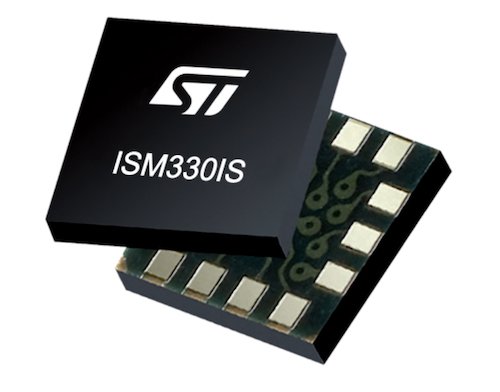
The ISM330IS measures 2.5 x 3.0 x 0.83 mm. Image used courtesy of STMicroelectronics
This article unpacks some recent IMU releases and a recent collaboration the company announced with other industry leaders.
First, a Quick Review of Inertial Measurement Units
Inertial measurement units (IMUs) are a type of sensor that measures angular rate, force, and magnetic field. A 6-axis IMU comprises a 3-axis accelerometer and a 3-axis gyroscope. Alternatively, a 9-axis IMU integrates an additional 3-axis magnetometer with the existing accelerometer and gyroscope.
While the accelerometer measures acceleration across a single axis and gravity as a downward force, the gyroscope measures angular velocity about the x-, y-, and z-axes (i.e., pitch, roll, and yaw, respectively). Conversely, the magnetometer leverages the magnetic flux density of the air to detect fluctuations in the earth’s magnetic field.
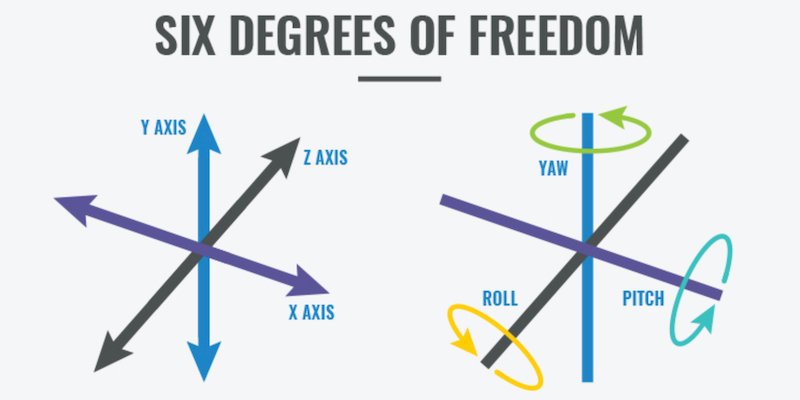
An IMU can offer up to six degrees of freedom. Image (modified) used courtesy of CEVA
With the help of sensor fusion software, an IMU can efficiently determine motion, orientation, and heading using a combination of the acceleration, angular velocity, and magnetic field measurements from the accelerometer, gyroscope, and magnetometer. The sensor offers up to six degrees of freedom (DOF) for enhanced object motion detection within a three-dimensional space.
IMUs are essential for several consumer, automotive, and industrial applications. Designers incorporate these sensors into global positioning systems (GPS) for real-time positioning, consumer electronics for motion tracking, and augmented reality/virtual reality (AR/VR) systems. Integrating several IMU-based technologies in autonomous vehicles, smart homes, and the industrial internet of things (IIoT) enables indoor and outdoor localization of people and objects.
ST Incorporates AI/ML into an IMU
In a recent announcement, STMicroelectronics noted that its latest ISM330IS always-on 6-axis IMU includes an intelligent sensor processing unit (ISPU) that enables artificial intelligence (AI) training inside the sensor. ST claims that this 6-axis IMU incorporates pattern recognition and anomaly detection in smart sensors.
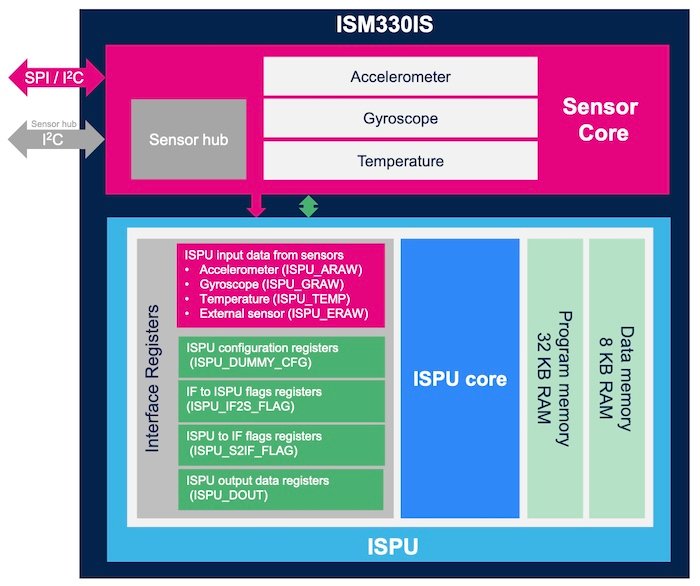
ISPU block diagram. Image used courtesy of STMicroelectronics
Because of its advanced motion-detection capability, ISM330IS does not require external microcontrollers (MCUs), shrinking its footprint and power consumption by up to 50%, according to the datasheet. This small package size may allow designers to maintain an established circuit board layout when upgrading from conventional inertial modules.
ISM330IS comprises a 3-axis accelerometer and 3-axis gyroscope. ST incorporated the ISPU into this sensor to support machine learning (ML) applications and binary neural networks. Developers can utilize NanoEdge AI Studio from ST to program the ISPU for AI deployments and to automatically generate optimized ML libraries. The studio helps developers design and incorporate a simplified AI learning-based anomaly detection library into the ISPU, regardless of their data science proficiency level.
Wacom, ST, and CEVA Team Up to Enhance Digital Pens
ST, Wacom, and CEVA recently teamed up to enhance the digital pen experience for tablets, smartphones, notebooks, interactive whiteboards, PCs, and other smart-display products. This collaboration aims to introduce a digital pen product that can streamline and simplify workflows for professionals, students, and others.
Each company contributed specific technologies to extend the capability of digital pens through advanced gesture, motion, and cursor control. For instance, this new digital pen includes the active ES (AES) rear IMU module—a combination of the digital pen technology from Wacom and a modified version of the low-power 6-axis IMU sensor and Bluetooth Low-energy system-on-chip (SoC) from STMicroelectronics. This IMU module is said to feature a low-power, highly-compact product design.
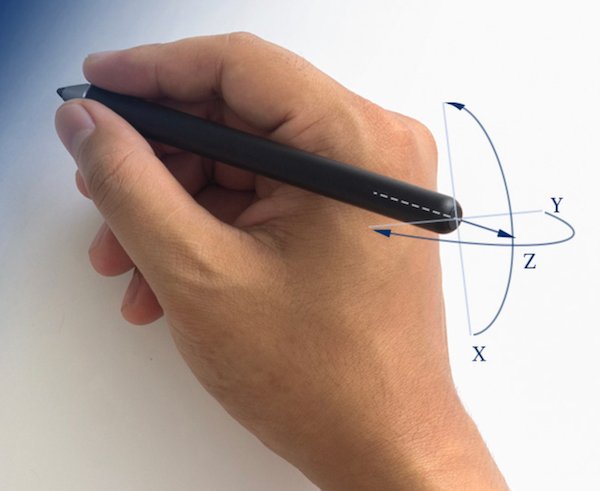
Wacom, ST, and CEVA collaborate to enhance the digital pen experience. Image used courtesy of STMicroelectronics
The MotionEngine Air motion-control software from CEVA offers orientation compensation and adaptive tremor-removal technology for an intuitive and consistent user experience. The collaboration is working on releasing a complete reference design to assist original equipment manufacturers (OEMs) develop branded motion-sensing digital pens for the market.
Machine Learning-embedded IMUs Bolster Vehicle Autonomy
ASM330LHHX, another ML-embedded IMU from ST, is a 6-axis module with a 3-axis digital accelerometer and a 3-axis digital gyroscope. This device is designed for movement and attitude sensing in vehicle positioning and digital stabilization applications, the datasheet notes.
With its ML core, the automotive application-based IMU may bolster a vehicle’s advanced driver assistance system (ADAS). ST directly integrated the sensor with AI algorithms on which the ML core runs to enable ultra-low latency between event sensing and vehicular response. This integration results in lower system energy and computing power compared to conventional solutions embedded in an application processor or cloud-based AI.
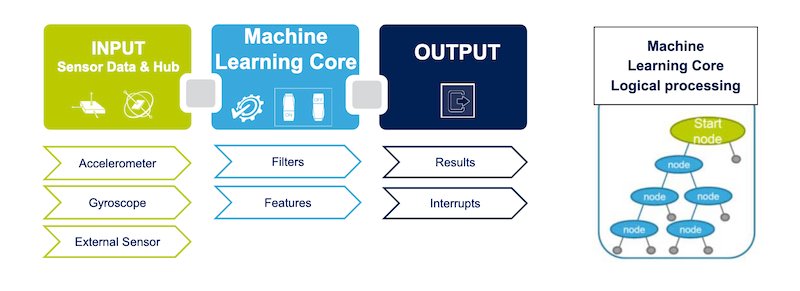
Embedded machine learning core in ST’s automotive IMU. Image used courtesy of STMicroelectronics
The sensing capabilities of the ASM330LHHX may be useful for altitude and heading reference, vehicle-stationary detection, altitude estimation, vehicle-stationary detection, altitude estimation, and crash detection. The sensor offers a wide temperature range of -40°C to 105°C, ensuring consistently high accuracies regardless of ambient and system temperatures.
The sensor also exhibits a low-power mode, making it applicable for anti-theft systems, telematics, vibration monitoring and compensation, motion-activated functions, and other always-on applications. ST incorporated an additional high-performance mode into the ASM330LHHX for high-accuracy, low-latency applications such as vehicle-to-everything (V2X) communication, precise positioning, impact detection, and crash reconstruction.
Benefits and Limitations of AI Training in an IMU
A significant challenge with incorporating AI training into IMUs is the larger footprints of these products. However, ST claims to have mitigated this challenge by incorporating a small ISPU that eliminates the need for additional external MCUs, reducing the footprint and power consumption of the module.
Incorporating AI training into the sensor:
- Increases efficiency and performance for pattern recognition and anomaly detection
- Offers an ultra-low-power programmable core for signal processing execution
- Leverages high-performance AI algorithms on the edge
The AI-enabled IMU from ST is said to optimize motion results in IoT and industrial solutions and provide real-time algorithms for Industry 5.0 applications, such as asset tracking, anomaly detection, and factory automation.

